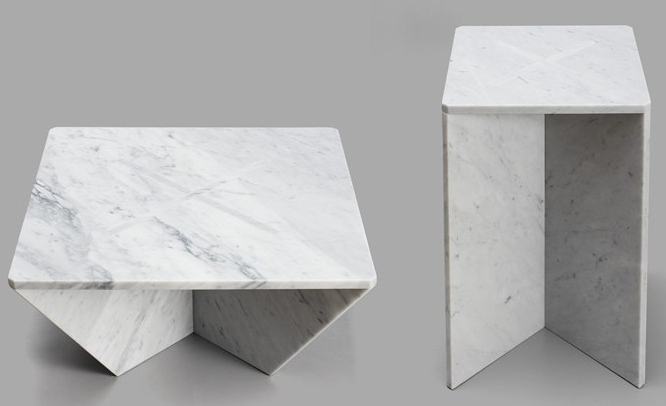Marble is considered one of the most attractive materials in terms of aesthetic and technical and operational qualities. However, the use of this stone is accompanied by difficulties in processing and transportation. And this is not to mention the high cost of a natural mineral. Actually, the same situation is observed with a number of other rocks, including granite. Get rid of such shortcomings allow the production technology of artificial analogues. In particular, cast marble has a more affordable price and allows you to get the desired shape of the final product even at the manufacturing stage. It can be an interior item, a purely decorative element of garden decoration or a panel for cladding. Of course, there is no need to talk about the complete resemblance to the natural prototype in the case of composite materials, but the imitation justifies itself in terms of basic characteristics.

What is cast marble?
This is a material that is created on a polymer basis with the inclusion of fillers. The production technology itself implies ample opportunities for changing the aesthetic properties of this stone. Compared to natural marble, the composite analogue makes it possible to use any color shades, not limited to the size of the product. It should also be noted and the difference from the classical technology for the production of artificial stones. In contrast to materials created using cement, cast marble involves the use of polymers as a binder. Thanks to this technological feature, high operational properties are achieved. Among them are noted: solidity, moisture resistance, optimal thermal conductivity, etc.
Manufacturing technology
Despite providing a wide range of positive qualities, the manufacturing process of marble is quite simple. Enterprises use special matrix forms for this purpose, in which a prepared raw material base is located. The formation of the final product occurs by molding - the tank is filled with a mixture of filler and additives, which subsequently hardens. At the same time, there are several methods by which cast marble is produced. The technology in the standard scheme involves the use of polyester resins. By introducing this component at the output, a product is obtained that can be used in home decoration. It is by this technology that parts and complete interior objects are produced. In practice, the feature of cast marble is felt even with a normal touch - the material gives off heat. This quality distinguishes stone from natural marble and granite.

Molds for products
Much as the implementation of the technological process depends on the equipment used, the main element of which is the mentioned form, that is, the matrix. Ready-made equipment exists on the market, but in most cases, manufacturers purchase matrices on special order. The fact is that molds for cast marble determine what the final product will be. Therefore, we are not talking about the standards for the performance of such equipment - each manufacturer seeks to make his products unique, and therefore matrix designs are developed as copyright designs with unique sizes and textures. Another thing is that in each case high demands are made on the material of the manufacture of the molds.Usually a composite material is used, similar in characteristics to plastic, but, of course, much stronger and more durable.

Cast Marble Raw Material
In addition to form, such products differ in composition. A standard set of components includes filler, polyester resin and gelcoat. The basis is the filler, which, by the way, is the most affordable component of the raw material kit. Typically, this component of the mixture is stone or concrete waste. As for gelcoat, it refers to specialized additives. Thanks to this element, high strength and moisture resistance are achieved - properties that high-quality cast marble has. The production of the material also involves the introduction of polyester resins. This is an important component, due to which the product acquires the durability of the structure and optimal viscosity.
Products based on cast marble
The flexibility of the manufacturing process allows us to diversify the shapes and sizes of the resulting products. For this feature, the material is appreciated by lovers of original design solutions. Specialists identify three main areas in which manufacturers of these products work. The first group includes materials intended for cladding: tiles, facade panels, stone boards, etc. The second group consists of cast marble products in the form of interior accessories and furniture. It can be countertops, flowerpots, candlesticks, kitchen surfaces and other objects. However, the greatest interest among true connoisseurs of cast marble is caused by the products that form the staircase structures. Manufacturers form entire series in which you can find steps, handrails, balustrades and other accessories.
Features of industrial cast marble
This kind of artificial marble is also called polymer concrete. Its peculiarity lies in the lack of decorative qualities and enhanced properties of vibration and chemical resistance. These characteristics and determined the scope of use of the material. Usually it is used in structures that require protection from physical influences. In particular, cast marble for industrial use is used in the manufacture of platforms for machine tools and equipment, containers for chemical compositions, breakwaters, drainage structures, etc. It must be said that this material significantly exceeds the traditional concrete structures in terms of durability and impact resistance.

Manufacturers
Domestic enterprises are still only mastering this technology, drawing on the experience of foreign companies. Nevertheless, on the market you can find quite good quality products. The high level of technical and operational performance of their products is demonstrated by such manufacturers of cast marble as Sanola, Avstrom and Decorlit. The Royal Cream Stone company, which has its own enterprises in Kazakhstan and Europe, also offers a wide assortment. A feature of the proposals from these manufacturers is the possibility of cooperation on individual orders, which allows you to purchase unique in form and texture execution of products from cast marble.
It is also worth noting that the manufacture of marble by injection technology is available to private craftsmen. The purchase of raw materials is the minimum share of the total cost of the product. According to some estimates, the standard size of the countertop has a cost of 500-600 rubles. Of course, for its manufacture, in addition to raw materials, special equipment in the form of the same matrix will be required. Therefore, rely on such an enterprise should only be in the case of regular use of technology.

Cast Marble Reviews
Of course, different materials are found on the market, but in the best samples, artificial stones in some respects even surpass the characteristics of natural analogues. Owners of furniture, for example, celebrate unique color and texture solutions. Over time, the texture on the surfaces does not fade even in adverse operating conditions. The technical and physical advantages of cast marble are also noted. Reviews, for example, emphasize the resistance of structures to destruction processes under the influence of external factors. For the most part, such marble allows direct contact with water, so it can be used both in the bathroom and on the street. In both cases, the owners did not report a deleterious effect on the characteristics of the material.

Conclusion
With all the positive aspects of the use of artificial stone, only in rare cases, designers are able to repeat the same stylistic effect that is achieved when using genuine stone. In this regard, the manufacture of cast marble is the most profitable because of the variety of decorative variations. In addition, the cost of production of this material allows you to minimize the final price of the product. Those who want to decorate their home with a noble mineral, but do not have the appropriate financial capabilities, it makes sense to turn to cast marble. It can be used not only as a decorative element, but also as a full-fledged building material. Wall cladding and the formation of stair structures are only part of the areas in which you can uncover the advantages of this excellent stone.








